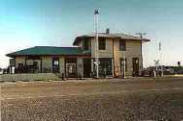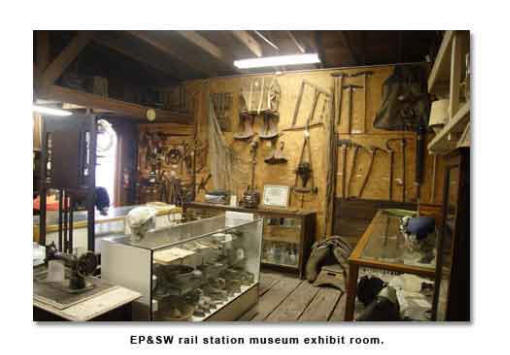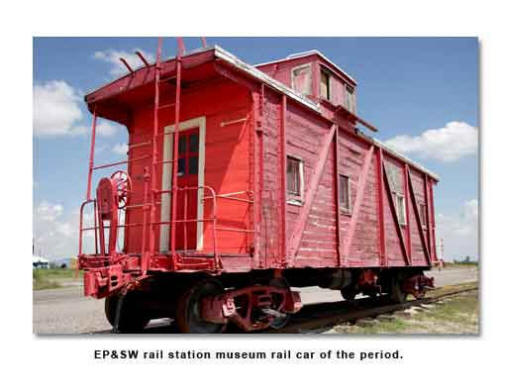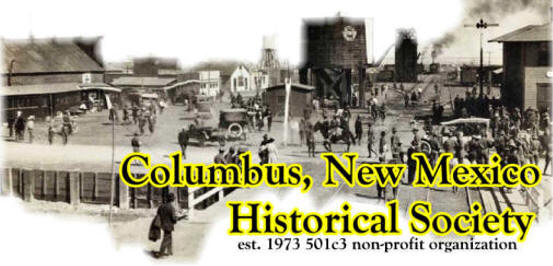|
Columbus Train Depot Museum |
Columbus, New Mexico — Pancho Villa and
the Railroad Depot Museum
- By Allen Rosenberg

The Railroad Depot
Museum Photo courtesy
Railroad Depot Museum.
|
What
vision comes to mind when you hear the name Pancho
Villa? Bandit, hero, valiant leader, ruthless tyrant?
All of those names have been associated with him. He was
not an easy man to define; it would depend on when you
met him during his career. Here in Columbus,
New Mexico, the same holds true. Some of our citizens
have been told by their older relatives that he was a
defender of the people. Others say he killed many of his
countrymen in their villages.
Here in
Columbus, we saw the results of his raid. Over 500
Villista’s attacked our town in the predawn hours of
March 9, 1916. By the time the raid was over, one half
the invaders were killed or wounded and 18 Americans
were dead. This was the last time a foreign government
invaded the Continental United States before the
9/11/2001 attack on the World Trade Center and Pentagon..
In
retaliation for the raid, President Wilson formed a
military group to attack and capture Pancho Villa under
the leadership of General "Black Jack" Pershing. In the
space of one week, Pershing not only drew up the
logistical plan for the campaign, but actually had
troops on the way to Columbus where he would march into
Mexico. In a remarkably short time, the Punitive
Expedition entered Mexico and tried to track Villa to
his lair. With all the men, horses, mules and might of
10,000 troops, 11 months later our army had never once
met up with Villa’s main force. They fought many small
battles but never a big one. This was guerrilla warfare
at its most effective. We were the foreign invaders.
Everyone was against us even if they weren’t for Villa.

It was
an educational time for our armed forces. This was the
first time that Americans used mechanized vehicles in
combat. This included cars and trucks (purchased on the
open market) from auto dealers in El Paso and other
locations. At that time, cars were not in general use;
the drivers were given rudimentary instructions and told
to drive. It wasn’t uncommon to hear the drivers
shouting "giddy up" and "whoa" instead of pushing the
proper pedals in the vehicles. The first armored
vehicles were used here. They were the forerunners of
tanks. Motorcycles also were used in combat conditions.
They (and mules) often would have machine guns mounted
as they rode into combat. As an interesting sidenote,
the regular paths that people used to get from one
village to another were too rough for our vehicles so
the Army Corp of Engineers improved the road between
Columbus and Casas Grande, Mexico.
This
effort also included the first use of airplanes in
combat conditions. Our entire air force (eight planes)
was stationed in Columbus, a squadron of the signal
corps. Up to this time, planes were used to carry
messages. Here, since they were underpowered, they flew
so low they would draw fire from people on the ground.
In self-defense, they carried grenades as bombs and shot
back at the ground troops. The planes were also used as
observers for the first time; they located suspected
enemies and carried the news back to the troops. It was
an exciting time for the U.S. troops. More than twenty
thousand troopers gained experience in combat conditions
which proved to be of great value as the U.S. entered
into the European theater the following year when they
returned from Mexico.
What
effect did this have on Columbus? While the troops were
here, Columbus was the largest settlement in New Mexico.
But when they left, it became smaller than before. Over
the years the town dwindled in size until the trains
stopped running in the 1950s. The population dropped to
around 200 and the village was listed in many locations
and guides as a ghost town. Now we are up to about the
size of the village at the time of the raid, around 1700
people. We still maintain our rural character but with a
surprise or two for the visitors to our area.

Our
Railroad Depot Museum was the railroad depot at the time
of the raid and was one of the principal targets. The Villistas wanted loot, money and goods to help finance
their war against the Nationalist Army. Shots were
fired at the depot, which was closed for the night. The
only real casualty was a wall clock that stopped when it
was hit by a bullet and recorded the time of the start
of the raid. The clock is currently being held in Santa
Fe and will only return when we can guarantee its
safety. The museum has an excellent collection of photos
of scenes taken both in Columbus and throughout the area
of the Punitive Expedition. Watch the videos that were
made about Pancho Villa and his raid. Examine the
artifacts of the soldiers stationed here and imagine
spending a winter chasing after a bandit at high
altitudes in the mountains of Chihuahua, Mexico. Look at
the display of weapons that were used on both sides. We
also have a copy of Pancho Villa’s death mask as well as
one of his sombreros.
When
you have had your fill of death and destruction, the
other rooms in the depot will give you an idea of life
on the frontier around the turn of the century. Costumes
and implements fill the walls and display cases. We even
have some railroad memorabilia. In May of 2000, a
painting of our entire air force of early 1916 was
unveiled in town. Three days later the painting was
presented to the Pentagon in Washington, DC. We are
proud to offer signed and numbered prints for sale.

Annual March 9th,
Columbus Memorial Day Event
Everyone is invited
to attend.
Visit
the official Columbus Historical Society /
Railroad Depot
Museum
website
Visit the Museum Facebook page here
Click
to visit our page sponsor:
|